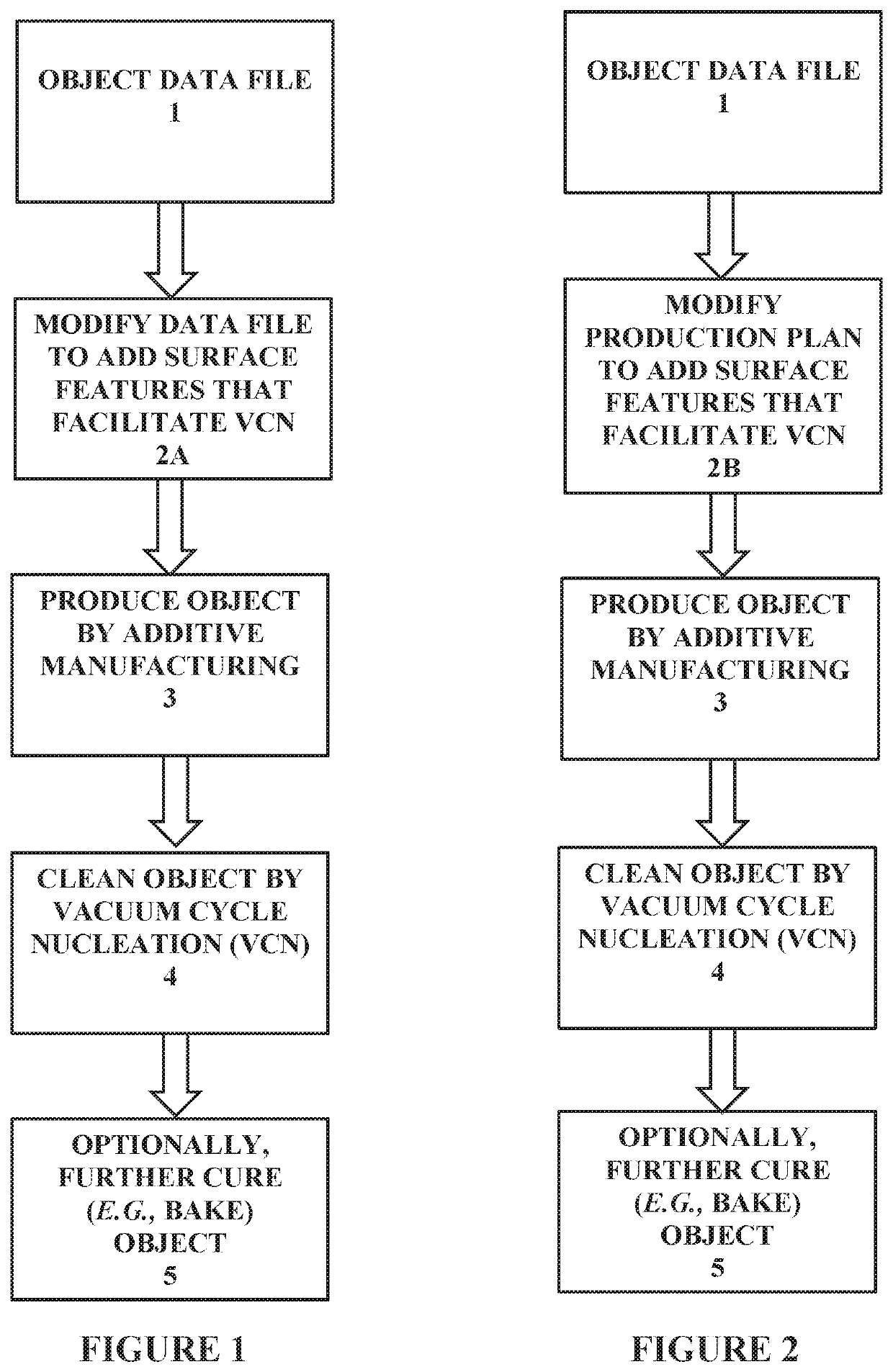Cleaning of additively manufactured objects by vacuum cycling nucleation
a technology of additive manufacturing and vacuum cycling, which is applied in the direction of cleaning using liquids, manufacturing tools, chemistry apparatus and processes, etc., can solve the problems of causing damage to more aggressive cleaning
- Summary
- Abstract
- Description
- Claims
- Application Information
AI Technical Summary
Benefits of technology
Problems solved by technology
Method used
Image
Examples
examples 1-2
[0070]Two proof-of-principle experiments were performed to evaluate the use of vacuum cycle nucleation (VCN) to wash uncured resin from 3D-printed parts. The first experiment was intended to only evaluate the effectiveness of resin removal from challenging part geometries. The second experiment allowed investigation of both washing effectiveness and the properties of finished 3D-printed parts made from a dual cure resin after baking of those parts.
[0071]In both experiments, 99% isopropyl alcohol (IPA) as a wash liquid was first heated in a flask to a desired temperature using a heated water bath. Test samples were then submerged in the heated IPA inside the flask, and the flask was attached through a 3-way valve and a cold trap to a vacuum pump. To begin the wash process, the vacuum pump was used to lower the pressure in the flask below the wash liquid vapor pressure, nucleating vapor bubbles on the part. The 3-way valve was then manually operated to close the line to the vacuum pum...
example 1
VCN Cleaning of Resin from Pre-Formed Parts
[0072]In this example, a viscous elastomeric polyurethane dual cure additive manufacturing resin was manually injected into two pre-formed test samples to coat their internal and external surfaces. The first test sample was a finished 3D-printed elastomeric polyurethane part with a 3D lattice geometry, and the second sample was a coiled section of fluorinated ethylene propylene (FEP) tubing. The lattice test sample was washed for 5 minutes in 50° C. IPA while cycling the absolute pressure in the cleaning flask between approximately 110 and 140 mbar. The coiled tubing was washed in 50° C. IPA for 10 minutes while cycling the pressure between 110 and 140 mbar. After washing, the test samples were visually inspected, and nearly all of the uncured resin had been removed from both internal and external surfaces.
[0073]For comparison, the coiled tubing was again injected with resin, and washing was performed with an orbital shaker containing room ...
example 2
VCN Cleaning and Baking of Additively Manufactured Parts
[0074]In this example, two parts with 3D lattice geometries were produced by bottom-up stereolithography from a viscous elastomeric polyurethane dual cure additive manufacturing resin, and then washed by VCN while still in in the green state. The test samples were washed for 2 minutes in 40° C. IPA while cycling the absolute pressure between approximately 85 and 120 mbar. After the first wash, a significant amount of uncured resin remained on the parts, so they were washed for 5 more minutes at 45° C. with the same pressure cycling.
[0075]For comparison, two more parts were produced in like manner and washed by spinning the parts in room temperature IPA.
[0076]The parts from both washing processes were then air dried and baked under usual conditions. The experimental VCN process and the control process appeared to be similarly effective at washing resin from the internal and external surfaces of the test samples. No substantial d...
PUM
| Property | Measurement | Unit |
|---|---|---|
| time | aaaaa | aaaaa |
| time | aaaaa | aaaaa |
| angles | aaaaa | aaaaa |
Abstract
Description
Claims
Application Information
 Login to View More
Login to View More - R&D
- Intellectual Property
- Life Sciences
- Materials
- Tech Scout
- Unparalleled Data Quality
- Higher Quality Content
- 60% Fewer Hallucinations
Browse by: Latest US Patents, China's latest patents, Technical Efficacy Thesaurus, Application Domain, Technology Topic, Popular Technical Reports.
© 2025 PatSnap. All rights reserved.Legal|Privacy policy|Modern Slavery Act Transparency Statement|Sitemap|About US| Contact US: help@patsnap.com



